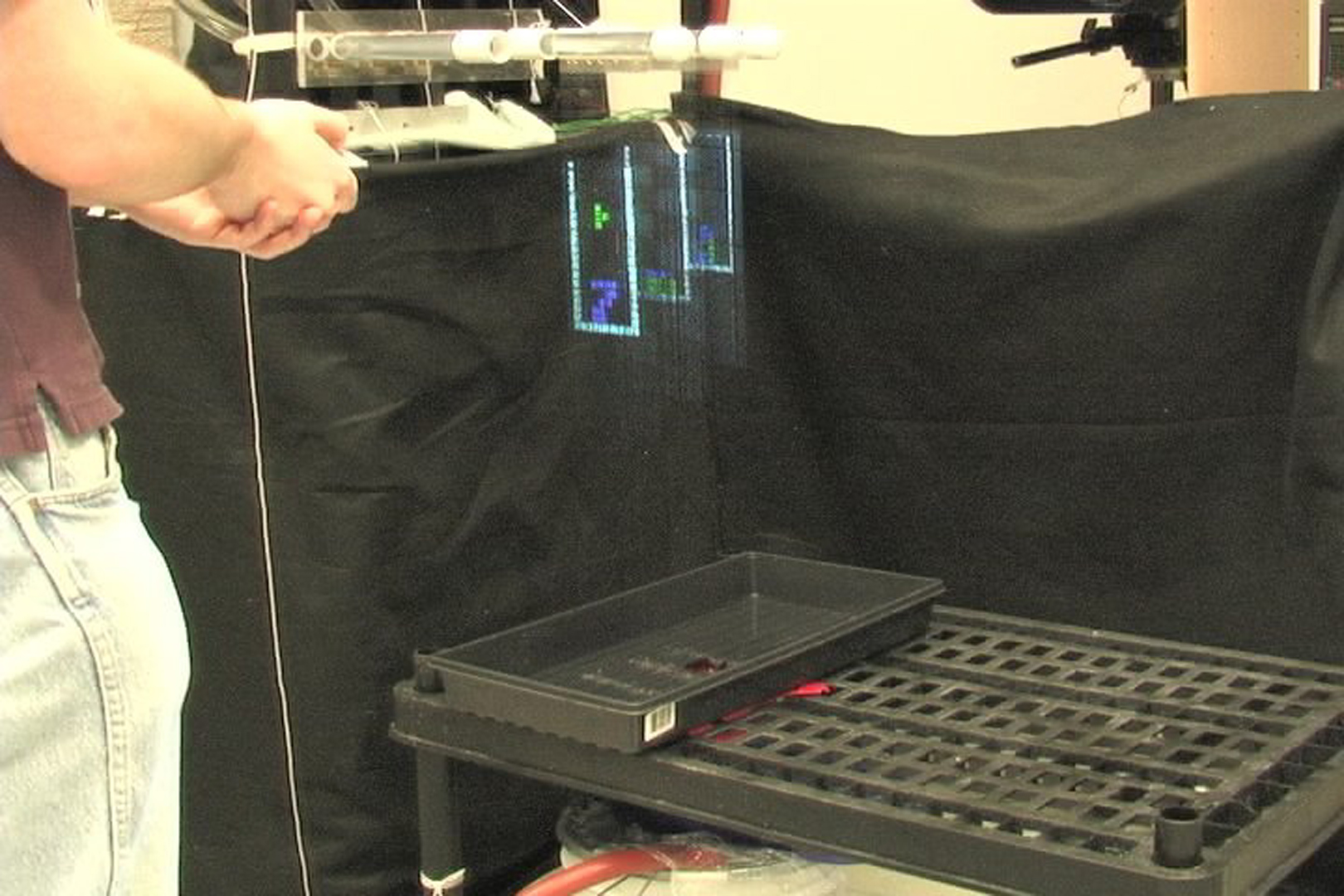“A multi-layered display with water drops” by Barnum, Narasimhan and Kanade
Conference:
Type(s):
Title:
- A multi-layered display with water drops
Presenter(s)/Author(s):
Abstract:
We present a multi-layered display that uses water drops as voxels. Water drops refract most incident light, making them excellent wide-angle lenses. Each 2D layer of our display can exhibit arbitrary visual content, creating a layered-depth (2.5D) display. Our system consists of a single projector-camera system and a set of linear drop generator manifolds that are tightly synchronized and controlled using a computer. Following the principles of fluid mechanics, we are able to accurately generate and control drops so that, at any time instant, no two drops occupy the same projector pixel’s line-of-sight. This drop control is combined with an algorithm for space-time division of projector light rays. Our prototype system has up to four layers, with each layer consisting of an row of 50 drops that can be generated at up to 60 Hz. The effective resolution of the display is 50x projector vertical-resolution x number of layers. We show how this water drop display can be used for text, videos, and interactive games.
References:
1. Ambravaneswaran, B., Wilkes, E. D., and Basarana, O. A. 2002. Drop formation from a capillary tube: Comparison of one-dimensional and two-dimensional analyses and occurrence of satellite drops. Physics of Fluids 14, 8, 2606–2621.Google ScholarCross Ref
2. Araki, T., Kawamata, F., Ogino, M., Miyagawa, H., Kamata, T., Watanabe, M., and Miyashita, K. 1991. US Patent 5,067,653: Screen forming apparatus and method.Google Scholar
3. Barnum, P. C., Narasimhan, S. G., and Kanade, T. 2009. A projector-camera system for creating a display with water drops. In IEEE International Workshop on Projector-Camera Systems.Google Scholar
4. Dietz, P., Han, J. Y., Barnwell, J., Westhues, J., and Yerazunis, W. 2006. Submerging technologies. In SIGGRAPH Emerging Technologies. Google ScholarDigital Library
5. Disney. 1992-2010. Fantasmic!Google Scholar
6. Eitoku, S., Tanikawa, T., and Suzuki, Y. 2006. Display composed of water drops for filling space with materialized virtual three-dimensional objects. In IEEE conference on Virtual Reality. Google ScholarDigital Library
7. Eitoku, S., Nishimura, K., Tanikawa, T., and Hirose, M. 2009. Study on design of controllable particle display using water drops suitable for light environment. In ACM Symposium on Virtual Reality Software and Technology. Google ScholarDigital Library
8. Frohn, A., and Roth, N. 2000. Dynamics of Droplets. Springer.Google Scholar
9. Le, H. P. 1998. Progress and trends in ink-jet printing technology. Journal of Imaging Science Technology 42, 49–62.Google Scholar
10. Lee, C., DiVerdi, S., and Höllerer, T. 2007. An immaterial depth-fused 3D display. In ACM Symposium on Virtual Reality Software and Technology. Google ScholarDigital Library
11. Munson, B. R., Young, D. F., Young, D. F., Okiishi, T. H., and Huebsch, W. W. 2009. Fundamentals of Fluid Mechanics, 6th ed. Wiley.Google Scholar
12. Palovuori, K., and Rakkolainen, I. 2004. US Patent 6,819,487: Method and apparatus for forming a projection screen or a projection volume.Google Scholar
13. Perlin, K., and Han, J. Y. 2006. US Patent 6,997,558: Volumetric display with dust as the participating medium.Google Scholar
14. Pevnick, S. H. 1981. US Patent 4,294,406: Program controllable free falling water drop fountain.Google Scholar
15. Pruppacher, H. R., and Klett, J. D. 1997. Microphysics of Clouds and Precipitation, second revised and enlarged ed. Kluwer Academic Publishers.Google Scholar
16. Sanderson, C. 2008. Biometric Person Recognition: Face, Speech and Fusion. VDM-Verlag.Google Scholar




